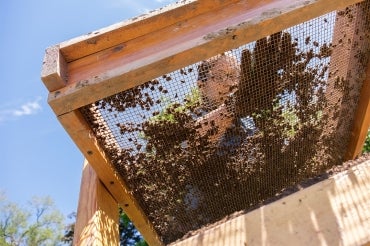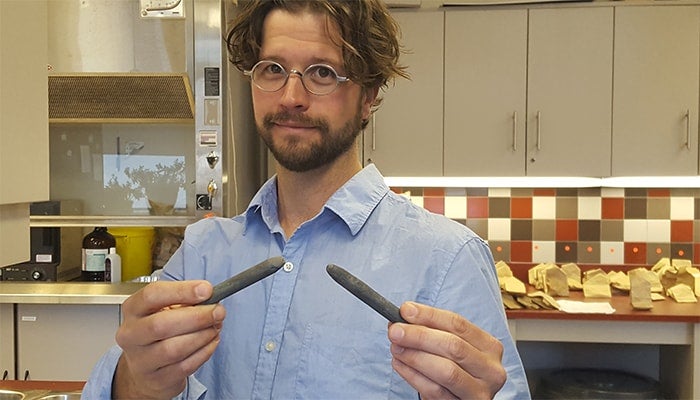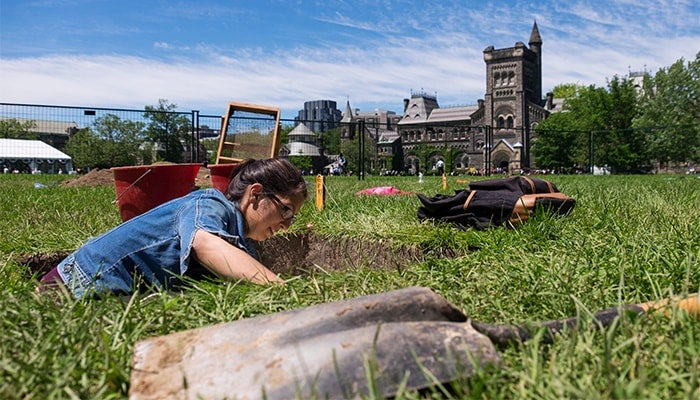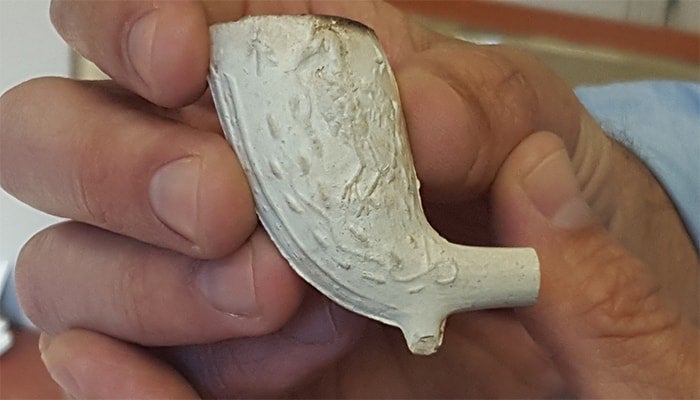Urban archaeology: U of T students excavate King's College Circle

Published: July 6, 2017
A pipe stummel with a Masonic symbol, a First World War military badge and coal from Victorian furnaces – these are some of the artifacts students found while excavating beneath U of T's King's College Circle.
“The undergrads will be the only people to have ever excavated there,” says Paul Duffy, a lecturer in the department of archaeology at U of T who was one of the archaeologists who oversaw the dig in the southeast corner of the circle.
Undergraduate students in the field work intensive archaeology course at U of T learned how to survey the land, dig, identify and catalogue artifacts. It was part of an ongoing urban archaeology project, mapping U of T’s downtown campus that has been running for eight years with previous excavations at the Lime Ridge Monument behind Gerstein Science Information Centre and Sir Daniel Wilson quadrangle at University College.
“It’s been a lot of fun and really hands on which makes it interesting – more interesting than reading textbooks and taking notes,” says Caitlyn Fleming, an archaeology major at U of T who is graduating in the fall.
While there are lots of modern debris in the top layers of the soil – plastic, shoelaces, bubble gum and newer coins – Duffy says that as students dig deeper, the objects can date back to the early 1800s.
According to documents and photographs contained in U of T Libraries, King’s College Circle has been used by military cadets, funeral processions, university sports teams and convocation celebrations. This archival documentation helped give context to some of the artifacts students hit upon in their dig.
“This is our chance to actually get evidence for use of the space and changes in its use over time,” says Duffy.
One of the more interesting finds, says Duffy, was a First World War infantry badge ostensibly left behind by one of the cadets who spent time around University College when the grounds there were being used for training exercises.
The students also found gun flint which Duffy says is probably British from the early 1800s, Victorian pottery and lots of coal from Victorian furnaces.

Paul Duffy in the department of archaeology lab showing carbon rods for a carbon-arc lamp found during U of T excavations. Behind Duffy, are dozens of paper bags containing artifacts that are now being cleaned and catalogued (photo by Hannah James)
But before they get down to the artifacts, there is a lot of prep work to be done.
Duffy says the students spent a week in late May mapping the topographic contours of the land. Then, they in June they began doing “shovel tests,” digging down 30 or 40 centimeters to see if there was any intact archaeological material.
At the excavation stage, each student was responsible for excavating a portion of the dig, going down two to ten centimetres, and recording stratigraphic changes and locations of artifacts.
Fleming says her pit was mostly clay, and digging through it was “about as interesting as it sounds”. Then, she says, she found a nail and some wood, which she said could have been evidence of a fence, which she says she found very intriguing and wanted to dig down as far as the professors would allow.
“I am more interested in structures than artifacts,” she said.

Corinne Harrilall, an archeology major, digs at the site. Students worked every day, rain or shine at King's College Circle (photo by Geoffrey Vendeville)
Each artifact is analyzed in the context in which it is found. Duffy explains that if an object is found among charcoal and other bits of rubble, students must consider what all these things could mean together as an event.
“Is it evidence of a hearth in situ or a fire that occurred?” says Duffy. He says students build these interpretations into a final report.
When the dig is complete, the artifacts are processed and catalogued in the department where they will eventually be made available to researchers from inside and outside U of T.
Fleming says that while she took the course as part of her major, she felt that documenting the city's history was especially important as Toronto continues to expand and grow.
“Urban archaeology can help us realize things we never knew about the city,” says Fleming.

A ceramic pipe stummel embossed with symbols – a Masonic sign and a bird – found near the Lime Ridge Monument at U of T (photo by Hannah James)



